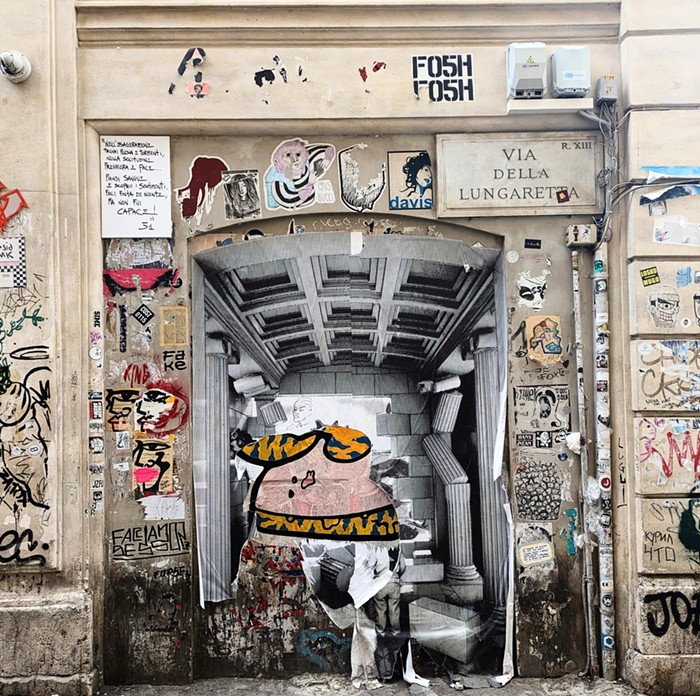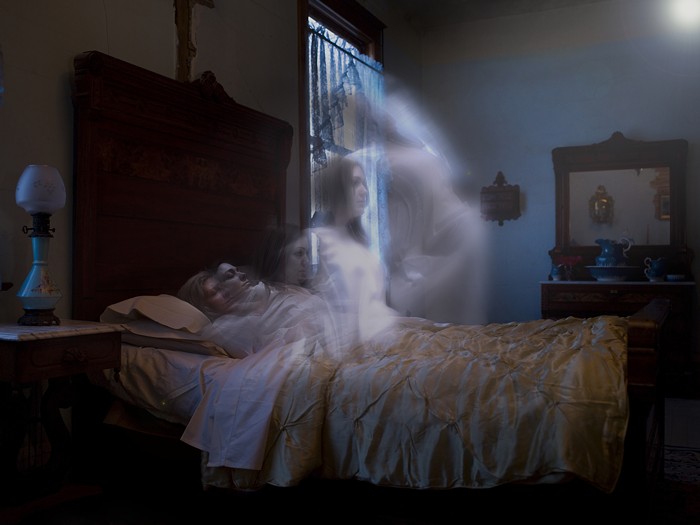To some people, it's heresy not to care much about a Jackson Pollock drip painting—in this case, the 1947 painting Sea Change, five feet tall and four feet wide, encrusted with pebbles whose earthy presence contrasts with the silver/orange/electric-blue/throbbing-city tones of the paint. But for years, I have mostly walked by SAM's Pollock, which today hangs smack in the middle of the third floor. Last week I found myself drawn to it.
I blame Derrick Cartwright, the (tragically) departing SAM director, who gave a talk entirely devoted to this painting the week prior. The talk was one of the best by an art historian that I've heard in Seattle—and it helps to explain why Cartwright is leaving, since, obviously, this, rather than museum administration, is the type of work he relishes. (Note: He mentioned that he's in the process of researching various moments of transformation—see sea change—in the careers of various artists. A forthcoming book?)
Cartwright stripped layers of historical dust away from the 64-year-old painting, and the result is nothing less than the equivalent of a restoration of the painting.
With assistance from his team of curators and conservators at SAM (whom he credited generously), Cartwright located Sea Change in a little-known photograph by Wilfred Zogbaum. The reason for the photo's obscurity is obvious—it doesn't depict Pollock in the way popular history wants him, tormented and alone. No, in this picture, he's smiling sort of goofily, clearly laughing with someone, maybe the photographer. In the picture, Sea Change stands up against the wall behind Pollock, Cartwright says. It faces backward, with a stretcher bar across its upper half (since removed, but the age mark from the bar remains).
Somehow, Cartwright and his team created a graphic that roughly maps the shapes and colors underneath the layers of drips. The graphic is a map of the understructure of Pollock's forest of paint. Cartwright shared an idea about the 1947 painting based on the artist's habits and the study of the painting's structure: "I feel fairly confident," he said, "that it's one of his 1946 paintings [from the Accabonac Creek series] being reused to create Sea Change."
A close examination of the surface of Sea Change also led Cartwright to theorize that it was probably painted in an upstairs bedroom at Pollock and Lee Krasner's house in Springs—not in the studio barn now visited by tourists (and where the Zogbaum and also Hans Namuth's well-known photos are set). Sea Change was painted on a wooden floor. But the width of the marks left by the floor beams on the surface of Sea Change are narrower than the beams in the barn, Cartwright said. That means that Sea Change was most likely finished upstairs, just as Pollock was on the cusp of moving into what would become his sacred—and final—creative space. The 1947 painting represented its theme in so many ways. (Drips descending a staircase...)
Sea Change was one of a small series of paintings Pollock showed at the Betty Parsons Gallery in New York in 1948. The series also included Full Fathom Five, now a prized possession at MoMA. At Betty Parsons, the paintings were not particularly well received. The publisher of Architectural Forum returned one before paying for it with a note: "It just doesn't seem to work in our living room." The original price for Sea Change was $650, while—"Get this, MoMA," Cartwright said—Full Fathom Five was only $600.
Shortly before Pollock died, Peggy Guggenheim was already trying to offload some of his works for tax breaks. She lived in Venice, where SAM's education director visited her palazzo. He was seated next to the director of the art museum at Smith College, who was trying like crazy to buy a Pollock that night. "Stick around, honey," Peggy told the SAM staffer, "and I'll give you one."
After 32 "unfailingly polite missives were exchanged across the oceans," as Cartwright put it, Guggenheim eventually decided to donate Sea Change to SAM.
By that point, Jackson Pollock was dead, his fatal car crash forever overshadowing that old goofy smile from the time of Sea Change.
Sea change: "The desire to imagine/the future." Those words are from Jorie Graham's 2008 book of poetry, also called Sea Change. As Cartwright goes forward into his own transition—his final day at the museum is June 30—we can only wish him well and hope he doesn't sail too far.
Meanwhile, take another look at that Pollock. ![]()

















